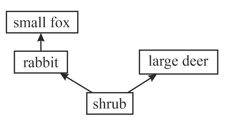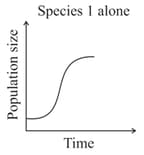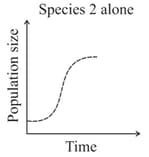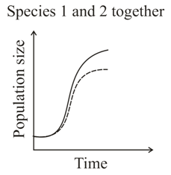On an oceanic island, long isolated away from any continent, there are only four co-existing species: flowering shrub, rabbit, large deer and small fox. The food web for the island ecosystem is depicted below.

Deer and rabbit eat precisely the same parts of the flowering shrub, depleting the shrub vegetation at precisely the same rates. If predation is NOT the reason that the four species coexist, choose the statement that best explains their coexistence.

Important Questions on Apply concepts of statistics and probability to support explanations that organisms with an advantageous heritable trait tend to increase in proportion to organisms lacking this trait.
Assertion (A): The Monarch butterfly feeds on poisonous weeds during its caterpillar stage.
Reason (R): It helps butterfly to become distasteful to the predator.
1) The human liver fluke, a nematode parasite, depends on two intermediate hosts (a snail and a fish) to complete its life cycle.
2) The malarial parasite needs a vector (mosquito) to spread to other host organisms.
3) In case of brood parasitism, the eggs of parasitic birds (e.g., cuckoo) are not detected and removed from the nest because the parasite's eggs resemble the host's eggs in morphology and colour.
4) A population of frogs protected from all predators would decrease indefinitely.
Match column-I with column-II and select the correct option.
| Column-I | Column-II | ||
| a) | Commensalism | i) | Lichen |
| b) | Mutualism | ii) | Plasmodium |
| c) | Parasitism | iii) | Hawk |
| d) | Predation | iv) | Orchid |
Given the graphs below, the interaction between species and can be classified as



Match the following. The correct combinations are
| The list I | List II | List III | |||
| (a) | Fig tree | (i) | Highly distasteful | (p) | Petals of its flower |
| (b) | Ophrys | (ii) | Cryptically coloured | (q) | Special chemical present |
| (c) | Sea anemone | (iii) | Wasp | (r) | Clownfish |
| (d) | Camouflage | (iv) | Sexual deceit | (s) | Developing seeds |
| (e) | Monarch butterfly | (v) | Stinging cells | (t) | Insects and frogs |

| Column-I | Column-II | ||
|---|---|---|---|
| Saprophyte | Symbiotic association of fungi with plant roots | ||
| Parasite | Decomposition of dead organic materials | ||
| Lichens | Living on living plants | ||
| Mycorrhiza | Symbiotic association of algae and fungi |
Choose the correct answer from the options given below:
Match the following?
| The list I | List II | ||
| (i) | Calotropis | (a) | Predator of Americana Pacific |
| (ii) | Cactus | (b) | Insects and frogs cryptically coloured |
| (iii) | Pisaster | (c) | Distasteful glycosides |
| (iv) | Monarch Butterfly | (d) | Cardiac glycosides |
| (v) | Camouflage | (e) | Predator is a moth |
Study the following table and pick up the correct combinations.
| S.No | Type of parasite | Lives in host | Example |
| I) | Cytozoic parasites |
Live among cells of tissues of host |
Plasmodium |
| II) | Histozoic parasites | Live within the host's cells | Wuchereria |
| III) | Coelozoic parasites | Live in cavities of host | Ascaris |
| IV) | Hyperparasites | Lives in the body of another parasite | Nosema |
Study the following table and pick up the correct combinations.
| S.No. | Interaction | Species A | Species B |
| I) | Mutualism | ||
| II) | Competition | ||
| III) | Predation | ||
| IV) | Parasitism | ||
| V) | Commensalism | ||
| VI) | Amensalism |

